Chapter: Artificial Intelligence
Propositional and Predicate Logic
Propositional and Predicate Logic
Logic is concerned with reasoning and the validity
of arguments. In general, in logic, we are not concerned with the truth of
statements, but rather with their validity. That is to say, although the
following argument is clearly logical, it is not something that we would
consider to be true:
All lemons are blue
Mary is a lemon
Therefore, Mary is blue
This set of statements is considered to be valid
because the conclusion (Mary is blue) follows logically from the other two
statements, which we often call the premises. The reason that validity and
truth can be separated in this way is simple: a piece of a reasoning is
considered to be valid if its conclusion is true in cases where its premises
are also true. Hence, a valid set of statements such as the ones above can give
a false conclusion, provided one or more of the premises are also false.
We can say: a piece of reasoning is valid if it
leads to a true conclusion in every situation where the premises are true.
Logic is concerned with truth values. The possible
truth values are true and false. These can be considered to be the fundamental
units of logic, and almost all logic is ultimately concerned with these truth
values.
Logic is widely used in computer science, and
particularly in Artificial Intelligence. Logic is widely used as a
representational method for Artificial Intelligence. Unlike some other
representations, logic allows us to easily reason about negatives (such as,
ŌĆ£this book is not redŌĆØ) and disjunctions (ŌĆ£orŌĆØŌĆösuch as, ŌĆ£HeŌĆÖs either a soldier
or a sailorŌĆØ).
Logic is also often used as a
representational method for communicating concepts and theories within the
Artificial Intelligence community. In addition, logic is used to represent
language in systems that are able to understand and analyze human language.
As we will see, one of the main
weaknesses of traditional logic is its inability to deal with uncertainty.
Logical statements must be expressed in terms of truth or falsehoodŌĆöit is not
possible to reason, in classical logic, about possibilities. We will see
different versions of logic such as modal logics that provide some ability to
reason about possibilities, and also probabilistic methods and fuzzy logic that
provide much more rigorous ways to reason in uncertain situations.
Logical Operators
In reasoning about truth values, we need to use a
number of operators, which can be applied to truth values.
We are familiar with several of these operators
from everyday language:
I like apples and oranges.
You can have an ice cream or a cake.
If you come from France, then you speak French.
Here we see the four most basic logical operators
being used in everyday language. The operators are:
and
or
not
if . . . then . . . (usually called implies)
One important point to note is that or is slightly
different from the way we usually use it. In the sentence, ŌĆ£You can have an
icecream or a cake,ŌĆØ the mother is usually suggesting to her child that he can
only have one of the items, but not both. This is referred to as an
exclusive-or in logic because the case where both are allowed is excluded.
The version of or that is used in logic is called
inclusive-or and allows the case with both options.
The operators are usually written using the
following symbols, although other
symbols are sometimes used, according to the
context: and Ōł¦
or Ōł©
not ’┐ó
implies ŌåÆ
iff Ōåö
Iff is an abbreviation that is commonly used to
mean ŌĆ£if and only if.ŌĆØ
We see later that this is a stronger form of
implies that holds true if one thing implies another, and also the second thing
implies the first.
For example, ŌĆ£you can have an ice-cream if and only
if you eat your dinner.ŌĆØ It may not be immediately apparent why this is
different from ŌĆ£you can have an icecream if you eat your dinner.ŌĆØ This is
because most mothers really mean iff when they use if in this way.
Translating between English and Logic Notation
To use logic, it is first necessary to convert
facts and rules about the real world into logical expressions using the logical
operators
Without a reasonable amount of experience at this
translation, it can seem quite a
daunting task in some cases.
Let us examine some examples. First, we will
consider the simple operators, Ōł¦, Ōł©, and
’┐ó.
Sentences that use the word and in English to
express more than one concept, all of which is true at once, can be easily
translated into logic using the AND operator, Ōł¦.
For example: ŌĆ£It is raining and it is Tuesday.ŌĆØ
might be expressed as: R Ōł¦ T, Where
R means ŌĆ£it is rainingŌĆØ and T means ŌĆ£it is Tuesday.ŌĆØ
For example, if it is not necessary to discuss
where it is raining, R is probably enough. If we need to write expressions such
as ŌĆ£it is raining in New YorkŌĆØ or ŌĆ£it is raining
heavilyŌĆØ or even ŌĆ£it rained for 30 minutes on
Thursday,ŌĆØ then R will probably not suffice. To express more complex concepts
like these, we usually use predicates. Hence, for example, we might translate
ŌĆ£it is raining in New YorkŌĆØ as: N(R) We
might equally well choose to write it
as: R(N)
This depends on whether we consider
the rain to be a property of New York, or vice versa. In other words, when we
write N(R), we are saying that a property of the rain is that it is in New
York, whereas with R(N) we are saying that a property of New York is that it is
raining. Which we use depends on the problem we are solving. It is likely that
if we are solving a problem about New York, we would use R(N), whereas if we
are solving a problem about the location of various types of weather, we might
use N(R).
Let us return nowto the logical
operators. The expression ŌĆ£it is raining inNew York, and IŌĆÖmeither getting sick
or just very tiredŌĆØcan be expressed as follows: R(N) Ōł¦ (S(I) Ōł© T(I))
Here we have used both the Ōł¦ operator, and the Ōł© operator to
express a collection of statements. The statement can be broken down into two
sections, which is indicated by the use of parentheses.
The section in the parentheses is
S(I) Ōł© T(I), which means ŌĆ£IŌĆÖm either getting sick OR IŌĆÖm very tiredŌĆØ.
This expression is ŌĆ£ANDŌĆÖedŌĆØwith the part outside the parentheses, which is
R(N).
Finally, the ’┐ó operator is
applied exactly as you would expectŌĆöto express negation. For example, It is not
raining in New York, might be expressed as ’┐óR(N)
It is important to get the ’┐ó in the right
place. For example: ŌĆ£IŌĆÖm either not well or just very tiredŌĆØ would be
translated as ’┐óW(I) Ōł© T(I)
The position of the ’┐ó here
indicates that it is bound to W(I) and does not play any
role in affecting T(I).
Now let us see how the ŌåÆ operator is used. Often
when dealing with logic we are discussing rules, which express concepts such as
ŌĆ£if it is raining then I will get wet.ŌĆØ
This sentence might be translated into logic as
RŌåÆW(I)
This is read ŌĆ£R implies W(I)ŌĆØ or ŌĆ£IF R THEN W(I)ŌĆØ.
By replacing the symbols R and W(I) with their respective English language
equivalents, we can see that this sentence can be read as ŌĆ£raining implies IŌĆÖll
get wetŌĆØ or ŌĆ£IF itŌĆÖs raining THEN IŌĆÖll get wet.ŌĆØ
Implication can be used to express much more
complex concepts than this.
For example, ŌĆ£Whenever he eats sandwiches that have
pickles in them, he ends up either asleep at his desk or singing loud songsŌĆØ
might be translated as S(y) Ōł¦ E(x, y) Ōł¦ P(y)ŌåÆA(x) Ōł© (S(x, z) Ōł¦ L(z))
Here we have used the following symbol
translations: S(y) means that y is a sandwich.
E(x, y) means that x (the man) eats y (the sandwich).
P(y) means that y (the sandwich) has pickles in it.
A(x) means that x ends up asleep at his desk.
S(x, z) means that x (the man) sings z (songs). L(z) means that z (the songs) are loud.
The important thing to realize is that the choice
of variables and predicates is important, but that you can choose any variables
and predicates that map well to your problem and that help you to solve the
problem.
For example, in the example we have just looked at,
we could perfectly well have used instead SŌåÆA Ōł© L where S means ŌĆ£he eats a sandwich which has
pickles in it,ŌĆØ A means ŌĆ£he ends up asleep at his desk,ŌĆØ and L means ŌĆ£he sings
loud songs.ŌĆØ
The choice of granularity is
important, but there is no right or wrong way to make this choice. In this
simpler logical expression, we have chosen to express a simple relationship
between three variables, which makes sense if those variables are all that we
care aboutŌĆöin other words, we donŌĆÖt need to know anything else about the
sandwich, or the songs, or the man, and the facts we examine are simply whether
or not he eats a sandwich with pickles, sleeps at his desk, and sings loud
songs.
The first translation we gave is more
appropriate if we need to examine these concepts in more detail and reason more
deeply about the entities involved.
Note that we have thus far tended to
use single letters to represent logical variables. It is also perfectly
acceptable to use longer variable names, and thus to write expressions such as
the following:
Fish (x) Ōł¦ living (x) ŌåÆhas_scales (x)
This kind of notation is obviously
more useful when writing logical expressions that are intended to be read by
humans but when manipulated by a computer do not add any value.
Truth Tables
We can use variables to represent possible truth
values, in much the same way that variables are used in algebra to represent
possible numerical values.
We can then apply logical operators to these
variables and can reason about the way in which they behave.
It is usual to represent the behavior of these
logical operators using truth tables.
A truth table shows the possible values that can be
generated by applying an operator to truth values.
Not
First of all, we will look at the truth table for
not, ’┐ó.
Not is a unary operator, which means it is applied
only to one variable.
Its behavior is very simple:
true is equal to false
false is equal to true
If variable A has value true, then ’┐óA has value false.
If variable B has value false, then ’┐óB has value true.
├ś These can
be represented by a truth table,
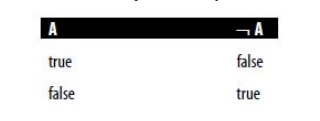
And
Now, let us examine the truth table for our first
binary operatorŌĆöone which acts on two variables:

Ōł¦
is also
called the conjunctive operator.
A Ōł¦ B is the
conjunction of A and B.
You can see that the only entry in the truth table
for which A Ōł¦ B is
true is the
one where A is true and B is true. If A is false,
or if B is false, then A Ōł¦ B is
false. If both A and B are false, then A Ōł¦ B is also false.
What do A and B mean? They can represent any
statement, or proposition, that can take on a truth value.
For example, A might represent ŌĆ£ItŌĆÖs sunny,ŌĆØ and B
might represent ŌĆ£ItŌĆÖs warm outside.ŌĆØ In this case, A Ōł¦ B would mean ŌĆ£It is sunny and
itŌĆÖs warm outside,ŌĆØ which clearly is true only if the two component parts are
true (i.e., if it is true that it is sunny and it is true that it is warm
outside).
Or
The truth table for the or operator, Ōł©
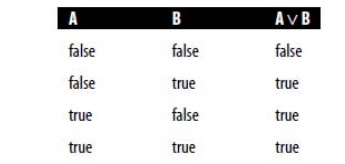
Ōł© is also called the disjunctive
operator.
A Ōł© B is the
disjunction of A and B.
Clearly A Ōł© B is true for any situation except when both A and B are false.
If A is true, or if B is true, or if
both A and B are true, A Ōł© B is true.
This table represents the
inclusive-or operator.
A table to represent exclusive-or
would have false in the final row. In other
words, while A Ōł© B is true if A and B are both true, A EOR B (A exclusive-or
is false if A and B are both true.
You may also notice a pleasing
symmetry between the truth tables for Ōł¦ and Ōł©. This will become useful later, as will a number of other
symmetrical relationships.
Implies
The truth table for implies (ŌåÆ) is a
little less intuitive.
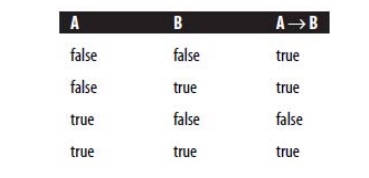
This form of implication is also known as material
implication
In the statement AŌåÆB, A is the antecedent, and B is
the consequent. The bottom two lines of the table should be obvious. If A is
true and B is true, then A ŌåÆ B seems to be a reasonable thing to believe.
For example, if A means ŌĆ£you live in FranceŌĆØ and B
means ŌĆ£You speak French,ŌĆØ then AŌåÆB corresponds to the statement ŌĆ£if you live in
France, then you speak French.ŌĆØ
Clearly, this statement is true (AŌåÆB is true) if I
live in France and I speak French (A is true and B is true).
Similarly, if I live in France, but I donŌĆÖt speak
French (A is true, but B is false), then it is clear that AŌåÆB is not true.
The situations where A is false are a little less
clear. If I do not live in France (A is not true), then the truth table tells
us that regardless of whether I speak French or not (the value of B), the
statement AŌåÆB is true. AŌåÆB is usually read as ŌĆ£A implies BŌĆØ but can also be
read as ŌĆ£If A then BŌĆØ or ŌĆ£If A is true then B is true.ŌĆØ
Hence, if A is false, the statement is not really
saying anything about the value of B, so B is free to take on any value (as
long as it is true or false, of course!).
All of the following statements are valid:
52 = 25 ŌåÆ4 = 4 (true ŌåÆtrue)
9 _ 9 = 123 ŌåÆ8 > 3 (false ŌåÆtrue)
52 = 25 ŌåÆ0 = 2 (false ŌåÆfalse)
In fact, in the second and third examples, the consequent
could be given any meaning, and the statement would still be true. For example,
the following statement is valid:
52 = 25 ŌåÆLogic is weird
Notice that when looking at simple logical
statements like these, there does not need to be any real-world relationship
between the antecedent and the consequent.
For logic to be useful, though, we tend to want the
relationships being expressed to be meaningful as well as being logically true.
Iff
├ś The truth
table for iff (if and only if {Ōåö}) is as follows:
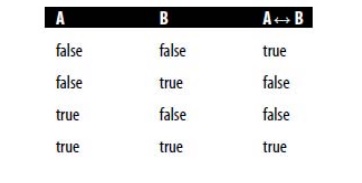
It can be seen that A Ōåö B is true as long as A and
B have the same value.
In other words, if one is true and the other false,
then A Ōåö B is false. Otherwise, if A and B have the same value, AŌåö B is true.
Complex Truth Tables
Truth tables are not limited to showing the values
for single operators.
For example, a truth table can be used to display
the possible values for A Ōł¦ (B Ōł©C).

Note that for two variables, the truth table has
four lines, and for three variables, it has
eight. In general, a truth table for n variables
will have 2n lines.
The use of brackets in this expression is
important. A Ōł¦ (B Ōł© C) is not the same as (A Ōł¦ B) Ōł© C.
To avoid ambiguity, the logical operators are
assigned precedence, as with mathematical operators.
The order of precedence that is used is as follows:
’┐ó, Ōł¦, Ōł©,ŌåÆ,Ōåö
Hence, in a statement such as ’┐óA Ōł© ’┐óB Ōł¦ C, the ’┐ó operator has the greatest
precedence, meaning that it is most closely tied to
its symbols. Ōł¦ has a
greater precedence than Ōł©, which
means that the sentence above can be expressed as (’┐óA) Ōł© ((’┐óB) Ōł¦ C)
Similarly, when we write ’┐óA Ōł© B this
is the same as (’┐óA) Ōł© B rather than ’┐ó(A Ōł© B)
In general, it is a good idea to use brackets
whenever an expression might otherwise be ambiguous.
Tautology
Consider the following truth table:
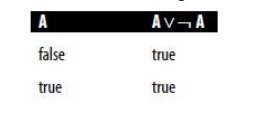
This truth table has a property that we have not
seen before: the value of the expression AŌł©’┐óA is true
regardless of the value of A.
An expression like this that is always true is called
a tautology. If A is a tautology, we write: |=A
A logical expression that is a tautology is often
described as being valid.
A valid expression is defined as being one that is
true under any interpretation.
In other words, no matter what meanings and values
we assign to the variables in a valid expression, it will still be true.
For example, the following sentences are all valid:
If wibble is true, then wibble is true.
Either wibble is true, or wibble is not true.
In the language of logic, we can replace wibble
with the symbol A, in which case these two statements can be rewritten as
AŌåÆA
Ōł©
’┐óA
If an expression is false in any interpretation, it
is described as being contradictory. The following expressions are
contradictory:
Ōł¦
’┐óA
(A Ōł© ’┐óA)ŌåÆ(A Ōł¦ ’┐óA)
Equivalence
Consider the following two expressions: A Ōł¦ B
B Ōł¦ A
It should be fairly clear that these two
expressions will always have the same value for a given pair of values for A
and B.
In otherwords, we say that the first expression is
logically equivalent to the second
expression.
We write this as A Ōł¦ B _ B Ōł¦ A. This means that the Ōł¦ operator is commutative.
Note that this is not the same as implication: A Ōł¦ BŌåÆB Ōł¦ A, although this second
statement is also true.
The difference is that if for two expressions e1
and e2: e1 _ e2, then e1 will always have the same value as e2 for a given set
of variables.
On the other hand, as we have seen, e1ŌåÆe2 is true
if e1 is false and e2 is true. There are a number of logical equivalences that
are extremely useful.
The following is a list of a few of the most
common:
A Ōł© A _ A
A Ōł¦ A _ A
A Ōł¦ (B Ōł¦ C) _ (A Ōł¦ B) Ōł¦ C (Ōł¦ is associative)
A Ōł© (B Ōł© C) _ (A Ōł© B) Ōł© C (Ōł© is associative)
A Ōł¦ (B Ōł© C) _ (A Ōł¦ B) Ōł© (A Ōł¦ C) (Ōł¦ is distributive over Ōł© )
A Ōł¦ (A Ōł© B) _ A
A Ōł© (A Ōł¦ B) _ A
A Ōł¦ true _ A
A Ōł¦ false _
false
A Ōł© true _
true
A Ōł© false _
A
All of these equivalences can be proved by drawing
up the truth tables for each side of the equivalence and seeing if the two
tables are the same.
The following is a very important equivalence: AŌåÆB
_ ’┐óA Ōł© B
We do not need to use the ŌåÆ symbol at allŌĆöwe can
replace it with a combination of ’┐ó and Ōł© .
Similarly, the following equivalences mean we do
not need to use Ōł¦ orŌåö:
A Ōł¦ B _ ’┐ó(’┐óA Ōł© ’┐óB)
AŌåö B _ ’┐ó(’┐ó(’┐óA Ōł© B) Ōł© ’┐ó (’┐óB Ōł© A))
In fact, any binary logical operator can be
expressed using ’┐ó and Ōł© . This is a fact
that is employed in electronic circuits, where nor
gates, based on an operator called nor, are used. Nor is represented by Ōåō, and
is defined as follows:
A Ōåō B _ ’┐ó(A Ōł© B)
Finally, the following equivalences are known as
DeMorganŌĆÖs Laws:
A Ōł¦ B _ ’┐ó(’┐óA Ōł© ’┐óB)
A Ōł© B _ ’┐ó(’┐óA Ōł¦ ’┐óB)
By using these and other equivalences, logical
expressions can be simplified.
For example, (C Ōł¦ D) Ōł© ((C Ōł¦ D) Ōł¦ E) can be simplified
using the following rule: A Ōł© (A Ōł¦ B) _ A hence, (C Ōł¦ D) Ōł© ((C Ōł¦ D) Ōł¦ E) _ C Ōł¦ D
In this way, it is possible to
eliminate subexpressions that do not contribute to the overall value of the
expression.
Propositional Logic
There are a number of possible systems of logic.
The system we have been examining so far is called
propositional logic.
The language that is used to express propositional
logic is called the propositional calculus.
A logical system can be defined in terms of its
syntax (the alphabet of symbols and how they can be combined), its semantics
(what the symbols mean), and a set of rules of deduction that enable us to
derive one expression from a set of other expressions and thus make arguments
and proofs.
Syntax
We have already examined the syntax of propositional
calculus. The alphabet of symbols, _ is defined as follows
= {true, false, ’┐ó,ŌåÆ, (, ),
Ōł¦, Ōł© ,Ōåö, p1, p2, p3, . . . , pn, . . . }
Here we have used set notation to define the
possible values that are contained within the alphabet Ōłæ.
Note that we allow an infinite number of
proposition letters, or propositional symbols, p1, p2, p3, . . . , and so on.
More usually, we will represent these by capital
letters P, Q, R, and so on,
If we need to represent a very large number of
them, we will use the subscript notation (e.g., p1).
An expression is referred to as a well-formed
formula (often abbreviated as wff) or a sentence if it is constructed
correctly, according to the rules of the syntax of propositional calculus,
which are defined as follows.
In these rules, we use A, B, C to represent
sentences. In other words, we define a sentence recursively, in terms of other
sentences.
The following are wellformed sentences:
P,Q,R. . .
true, false
(A)
’┐óA
A Ōł¦ B
A Ōł© B
AŌåÆB
AŌåö B
Hence, we can see that the following is an example
of a wff: P Ōł¦ Q Ōł© (B Ōł¦ ’┐óC)ŌåÆA Ōł¦ B Ōł© D Ōł¦ (’┐óE)
Related Topics